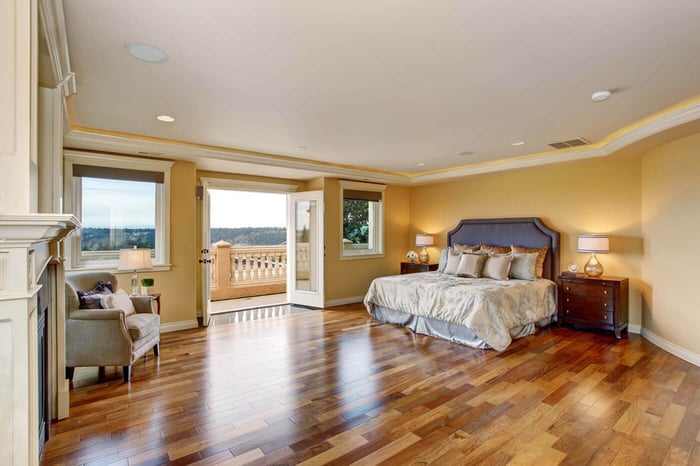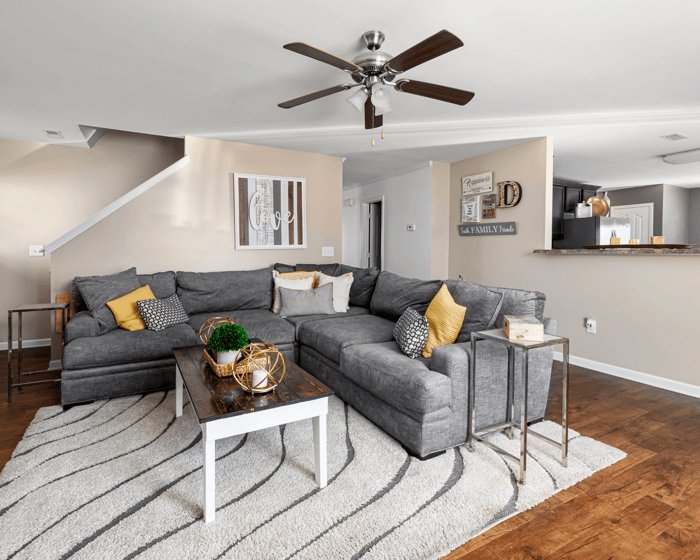If you dream of a home with timeless beauty and enduring style, wood flooring is likely at the top of your list. But with options like solid and engineered hardwood available, choosing the right fit for your home can feel a little overwhelming. Let's break down the key differences to help you make the perfect selection.
Solid Hardwood Flooring
Solid Hardwood flooring delivers unmatched beauty, with each wood species, like oak, maple, or cherry, bringing its own unique grain patterns and colors. This ensures your floors have a one-of-a-kind character.
Here's a breakdown of Oak, Maple, and Cherry hardwood flooring to help you decide which might be the right choice for your home:
Oak hardwood flooring comes from a widely available species, making it a cost-effective option. It comes in various colors, from light and airy to rich and golden, and features a prominent straight, open-grain pattern. Oak is known for its incredible strength and dent-resistance, which makes it ideal for high-traffic areas and bustling households. It ranks around 1360 on the Janka hardness scale, showcasing its exceptional hardness. Oak's timeless appearance complements a wide range of design styles, from traditional to contemporary.
Maple hardwood flooring is another popular choice, celebrated for its light and airy look. Its color palette ranges from creamy white to a light reddish-brown, and it has a fine, closed-grain pattern with a subtle figure. Maple is a very hard and durable wood but slightly less dent-resistant than oak, making it a good choice for areas with moderate traffic. With a Janka hardness ranking around 1450, maple is one of the hardest domestic hardwoods. Its light color and subtle grain pattern give it a clean, modern aesthetic, perfect for contemporary spaces.
Cherry hardwood flooring is prized for its rich color and warm tones. It starts with a lighter pinkish-red hue and darkens over time to a deep reddish-brown. Cherry has a closed, fine grain with a subtle figure. While a moderately hard wood and dent-resistant, it is softer than oak or maple and best suited for areas with lower traffic. Its Janka hardness ranking is around 950. Cherry's rich color and warm tones add a touch of elegance and luxury to any space, making it a statement piece.
With proper care, any solid hardwood floors can last for decades and even be refinished multiple times to revitalize their appearance. This longevity makes solid hardwood an excellent investment, often increasing a home's resale value.
Caring for Solid Hardwood Floors
Regular cleaning by sweeping or vacuuming prevents dirt and grit from scratching the surface. Use a cleaner specifically designed for hardwood to maintain its luster. Additionally, it's important to address spills right away and avoid excessive moisture exposure. Using felt pads under furniture legs and rugs in high-traffic areas adds a layer of protection against scratches.
Engineered Hardwood
Engineered wood flooring offers stability and versatility, but it comes in a few different construction varieties. The most common type features a plywood core made from multiple layers of plywood bonded together in a cross-grain pattern. A solid hardwood veneer tops the core, and this layered construction offers maximum dimensional stability against warping and cupping. Another option is an HDF (high-density fiberboard) core. HDF is made of compressed wood fibers and, although slightly less dimensionally stable than plywood, still provides a good level of resistance to moisture and humidity.
Newer types of engineered wood floors use either Stone Plastic Composite (SPC) or Wood Plastic Composite (WPC) cores. These floors tend to be thinner than traditional options and boast exceptional water resistance. This makes them ideal for moisture-prone areas like bathrooms, kitchens, and humid climates.
Beyond these main categories, there might be other core constructions for specialized applications of engineered wood floors. Additionally, consider other features like the thickness of the hardwood veneer, which determines how many times it can be sanded and refinished, and the wear layer (a protective finish). Like solid wood, engineered wood comes in various finishes, from glossy to matte and even textured styles.
Caring for Engineered Hardwood Floors
While engineered hardwood is more moisture-resistant than solid hardwood, it still benefits from a consistent care routine. Regular sweeping or vacuuming helps prevent scratches while using a cleaner formulated for hardwood floors ensures a beautiful finish. Engineered hardwood withstands some moisture, promptly address spills, and avoid excessive water exposure. The strategic placement of felt pads under furniture legs and rugs in high-traffic areas adds an extra layer of protection.
Things to Consider When Choosing
When deciding between solid and engineered hardwood, consider the location where you'll install the flooring. Basements and moisture-prone areas are better suited to engineered hardwood. Also, think about your budget, as solid hardwood can be more expensive upfront. Engineered hardwood can be a more budget-friendly option. Finally, consider how the floor will be used – if you have pets or children, solid hardwood's durability might be the better choice.
America's Flooring Source: Your Hardwood Flooring Experts
Decisions about your floors shouldn't leave you feeling overwhelmed! America's Flooring Source brings clarity and personalized expertise to your hardwood flooring project. Our knowledgeable staff, will guide you through the pros and cons of both solid and engineered hardwood, helping you select the flooring that aligns perfectly with your needs, budget, and style.
Discover the timeless beauty of wood flooring! Visit America's Flooring Source today for a personalized consultation and explore our stunning selection of both solid and engineered hardwood options.




